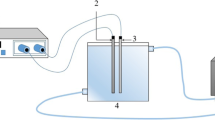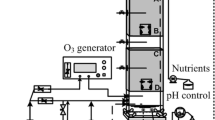Abstract
The effect of the injection of pure oxygen instead of air in a membrane bioreactor for the elimination of bisphenol A is investigated. A dynamic experiment was developed in a pilot plant where the aerobic reactor was continuously spiked with 1 mg L−1 of bisphenol A. Air was injected for 10 days and then pure oxygen was injected for another 10 days. The bisphenol A concentration was determined in aqueous phases and activated sludge using simple and sensitive analytical methods based on different extraction procedures and liquid chromatography tandem mass spectrometry analysis. Enzymatic activity was also determined and toxicity tests were performed to discard that the spiked bisphenol A concentration could negatively affect the microorganisms in the bioreactor and, thus, the membrane bioreactor performance. The effluent bisphenol A concentration increased up to 0.26 mg L−1 after 4 days in the air injection treatment, and up to 0.48 mg L−1 after only 12 h in the oxygen injection treatment. In both cases, this was followed by a decrease in concentration despite the continuous spiking of bisphenol A into the bioreactor. In presence of pure oxygen, bisphenol A concentration reached background levels (below the limit of quantification) after 5 days. In contrast, when using air a total of 10 days were required to reach background levels. The injection of pure oxygen instead of air is an important innovation in wastewater treatment, allowing permanent elimination of organic contaminants, avoiding their return to the environment and ensuring the safety of water.




Similar content being viewed by others
References
APHA (2001) Standard methods for the examination of water and wastewater. In: Clesceri LS, Greenberg AE, Eaton AD (eds) 20th Edn. American Public Health Association, Washington DC
Awong J, Bitton G, Koopman B (1985) ATP, oxygen uptake rate and INT-dehydrogenase activity of actinomycete foams. Water Res 19(7):917–921. doi:10.1016/0043-1354(85)90151-4
Boczar BA, Forney LJ, Begley WM, Larson RJ, Federle TW (2001) Characterization and distribution of esterase activity in activated sludge. Water Res 35(17):4208–4216. doi:10.1016/S0043-1354(01)00150-6
Bonefeld-Jørgensen EC, Long M, Hofmeister MV, Vinggaard AM (2007) Endocrine-disrupting potential of bisphenol A, bisphenol A dimethacrylate, 4-N-nonylphenol, and 4-N-octylphenol in vitro: new data and a brief review. Environ Health Perspect 115(1):69–76. doi:10.1289/ehp.9368
Cadoret A, Conrad A, Block JC (2002) Availability of low and high molecular weight substrates to extracellular enzymes in whole and dispersed activated sludges. Enzyme Microb Tech 31(1–2):179–186. doi:10.1016/S0141-0229(02)00097-2
Chen J, Huang X, Lee D (2008) Bisphenol A removal by a membrane bioreactor. Process Biochem 43:451–456. doi:10.1016/j.procbio.2008.01.001
Clara M, Kreuzinger N, Strenn B, Gans O, Kroiss H (2005) The solids retention time—a suitable design parameter to evaluate the capacity of wastewater treatment plants to remove micropollutants. Water Res 39(1):97–106. doi:10.1016/j.watres.2004.08.036
Drewes JE, Hemming J, Ladenburger SJ, Schaauer J, Sonzogni W (2005) An assessment of endocrine disrupting activity changes during wastewater treatment through the use of bioassays and chemical measurements. Water Environ Res 77:12–23. doi:10.2175/106143005X41573
Dutton RJ, Bitton G, Koopman B (1983) Malachite Green-INT (MINT) method for determining active bacteria in sewage. Appl Environ Microb 46(6):1263–1267. doi:0099-2240/83/121263-05$02.00/0
Environmental Protection Agency (2005) Cross-species mode of action information assessment: a case study of bisphenol A. Government Reports Announcements & Index, Issue 26, National Center for Environmental Assessment
Furuya M, Adachi K, Kuwahara S, Ogawa K, Tsukamoto Y (2006) Inhibition of male chick phenotypes and spermatogenesis by Bisphenol A. Life Sci 78(15):1767–1776. doi:10.1016/j.lfs.2005.08.016
Goel R, Mino T, Satoh H, Matsuo T (1998) Enzyme activities under anaerobic and aerobic conditions in activated sludge sequencing batch reactor. Water Res 32(7):2081–2088. doi:10.1016/S0043-1354(97)00425-9
Groshart CP, Okkerman PC (2001) Chemical study on Bisphenol A. BKH Consulting Engineers, Report: IKZ/2001.027, pp 1–94
Hohenblum P, Gans O, Moche W, Scharf S, Lorbeer G (2004) Monitoring of selected estrogenic hormones and industrial chemicals in groundwaters and surface waters in Austria. Sci Total Environ 333:185–193. doi:10.1016/j.scitotenv.2004.05.009
Hu JY, Chen X, Tao G, Kekred K (2007) Fate of endocrine disrupting compounds in membrane bioreactor systems. Environ Sci Technol 41(11):4097–4102. doi:10.1021/es062695v
Ivashechkin P, Corvini PFX, Dohmann M (2004) Behaviour of endocrine disrupting chemicals during the treatment of municipal sewage sludge. Water Sci Technol 50(5):133–140
Kang JH, Kondo F, Katayama Y (2006) Human exposure to bisphenol A—review. Toxicology 226(2–3):79–89. doi:10.1016/j.tox.2006.06.009
Kuch ML, Ballschmiter K (2001) Determination of endocrine-disrupting phenolic compounds and estrogens in surface and drinking water by HRGC-(NCI)-MS in the pictogram per liter range. Environ Sci Technol 35:3201–3206. doi:10.1021/es010034m
Lagana A, Bacaloni A, Leva ID, Faberi A, Fago G, Marino A (2004) Analytical methodologies for determining the occurrence of endocrine disrupting chemicals in sewage treatment plants and natural waters. Anal Chim Acta 501:79–88. doi:10.1016/j.aca.2003.09.020
Lenz K, Beck V, Fuerhacker M (2004) Behaviour of bisphenol A (BPA), 4-nonylphenol (4-NP) and oxidative water treatment processes. Water Sci Technol 50(5):141–147
Lindblom E, Press-Kristensen K, Vanrolleghem PA, Mikkelsen PS, Henze M (2009) Dynamic experiments with high bisphenol-A concentrations modelled with an ASM model extended to include a separate XOC degrading microorganism. Water Res 43(13):3169–3176. doi:10.1016/j.watres.2009.04.030
Liu R, Zhou JL, Wilding A (2004) Microwave-assisted extraction followed by gas chromatography—mass spectrometry for the determination of endocrine disrupting chemicals in river sediments. J Chromatogr A 1038(1–2):19–26. doi:10.1016/j.chroma.2004.03.030
Meeker JD, Sathyanarayana S, Swan SH (2009) Phthalates and other additives in plastics: human exposure and associated health outcomes. Phil Trans R Soc B 364:2097–2113. doi:10.1098/rstb.2008.0268
Mohapatra DP, Brar SK, Tyagi RD, Surampalli RY (2010) Physico-chemical pre-treatment and biotransformation of wastewater and wastewater sludge, fate of bisphenol A. Chemosphere 78(8):923–941. doi:10.1016/j.chemosphere.2009.12.053
Nascimento Filho I (2003) Identification of some plasticizers compounds in landfill leachate. Chemosphere 50(5):657–663. doi:10.1016/S0045-6535(02)00581-7
Press-Kristensen K, Lindblom E, Schmidt JE, Hense M (2008) Examining the biodegradation of endocrine disrupting bisphenol A and nonylphenol in WWTPs. Water Sci Technol 57(8):1253–1256. doi:10.2166/wst.2008.229
Rodríguez-Mozaz S, López de Alda M, Barceló D (2004) Monitoring of estrogens, pesticides and bisphenol A in natural waters and drinking water treatment plants by solid-phase extraction–liquid chromatography mass spectrometry. J Chromatogr A 1045:85–92. doi:10.1016/j.chroma.2004.06.040
Schmitt-Kopplin P, Burhenne J, Freitag D, Spiteller M, Kettrup A (1999) Development of capillary electrophoresis methods for the analysis of fluoroquinolones and application to the study of the influence of humic substances on their photodegradation in aqueous phase. J Chromatogr A 837(1–2):253–265. doi:10.1016/S0021-9673(99)00079-5
Schröder HF (2006) The elimination of the endocrine disrupters 4-nonylphenol and bisphenol A during wastewater treatment—comparison of conventional and membrane assisted biological wastewater treatment followed by an ozone treatment. Water Pract Technol 1:1–9. doi:10.2166/WPT.2006060
Smith SR (2009) Organic contaminants in sewage sludge (biosolids) and their significance for agricultural recycling. Phil Trans R Soc A 367:4005–4041. doi:10.1098/rsta.2009.0154
Spring AJ, Bagley DM, Andrews RC, Lemanik S, Yang P (2007) Removal of endocrine disrupting compounds using a membrane bioreactor and disinfection. J Environ Eng Sci 6(2):131–137. doi:10.1139/S06-049
Stangroom S, Collins C, Lester J (2000) Abiotic behaviour of organic micropollutants in soils and the aquatic environment. A review: 2 Transformations. Environ Technol 21(8):845–863. doi:10.1080/09593332108618060
Staples CA, Dom PB, Klecka GM, O’Block ST, Harris LR (1998) A Review of the environmental fate, effects and exposures of bisphenol A. Chemosphere 36(10):2149–2173. doi:10.1016/S0045-6535(97)10133-3
Stasinakis AS, Petalas AV, Mamais D, Thomaidis NS, Gatidou G, Lekkas TD (2007) Investigation of triclosan fate and toxicity in continuous-flow activated sludge system. Chemosphere 68(2):75–381. doi:10.1016/j.chemosphere.2007.01.047
Statgraphics CENTURION XVI, vs 16.0.07 (1982-2009), StatPoint Technologies Inc
Stowell CL, Barvian KK, Young PCM, Bigsby RM, Verdugo DE, Bertozzi CR, Widlanski TS (2006) A role for sulfation-desulfation in the uptake of bisphenol A into breast tumor cells. Chem Biol 13(8):891–897. doi:10.1016/j.chembiol.2006.06.016
Strotmann UJ, Pagga U (1996) A growth inhibition test with sewage bacteria. Results of an international ring test 1995. Chemosphere 32(5):921–933. doi:10.1016/0045-6535(95)00357-6
Takayanagi S, Tokunaga T, Liu X, Okada H, Matsushima A, Shimohigashi Y (2006) Endocrine disruptor bisphenol A strongly binds to human estrogen-related receptor gamma (ERRgamma) with high constitutive activity. Toxicol Lett 167(2):95–105. doi:10.1016/j.toxlet.2006.08.012
Talsness CE, Andrade AJM, Kuriyama SN, Taylor JA, Von Saal FS (2009) Components of plastic: experimental studies in animals and relevance for human health. Philos Trans R Soc B 364:2079–2096. doi:10.1098/rstb.2008.0281
UK-BRE (Building Research Establishment) (2000) Draft Risk Assessment of Bisphenol A of May 2000. Conducted by the UK rapporteur of behalf of the European Union by (BRE), UK
Vandenberg LN, Hauser R, Marcus M, Olea N, Welshons WV (2007) Human exposure to bisphenol A (BPA). A Review. Reprod Toxicol 24(2):139–177. doi:10.1016/j.reprotox.2007.07.010
Verma M, Brar SK, Tyagi RD, Sahai V, Prévost D, Valéro JR, Surampalli RY (2007) Bench-scale fermentation of Trichoderma viride on wastewater sludge: rheology, lytic enzymes and biocontrol activity. Enzyme Microb Tech 41(6–7):764–771. doi:10.1016/j.enzmictec.2007.06.013
Vethaak AD, Lahr J, Schrap SM, Belfroid AC, Rijs GB, Gerritsen A (2005) An integrated assessment of estrogenic contamination and biological effects in the aquatic environment of the Netherlands. Chemosphere 59:511–524. doi:10.1016/j.chemosphere.2004.12.053
Vílchez JL, del Olmo M, González-Casado A, Navalón A (2005) Patrones químicos monocloro, dicloro y tricloro derivados del bisfenol-A. Spanish Patent No 2190852
Wu C, Xue W, Zhou H, Huang X, Wen X (2011) Removal of endocrine disrupting chemicals in a large scale membrane bioreactor plant combined with anaerobic-anoxic-oxic process for municipal wastewater reclamation. Water Sci Technol 64(7):1511–1518. doi:10.2166/wst.2011.140
Zafra-Gómez A, Ballesteros O, Navalón A, Vílchez JL (2008) Determination of some endocrine disrupter chemicals in urban wastewater samples using LC-MS. Microchem J 88(1):87–94. doi:10.1016/j.microc.2007.10.003
Zhang C, Zeng G, Yuan L, Yu J, Li J, Huang G, Xi B, Liu H (2007) Aerobic degradation of bisphenol A by achromobacter xylosoxidans strain B-16 isolated from compost leachate of municipal solid waste. Chemosphere 68(1):181–190. doi:10.1016/j.chemosphere.2006.12.012
Acknowledgments
This work was supported by the regional Government of Andalusia (Research Contract No 3017-00 and Project P09-CTS-4470) and by the Spanish Ministry of Education, Culture and Sports (Project No CTQ2011-24210). The authors are grateful to the Spanish Ministry of Foreign Affairs (Agency for International Cooperation) for the fellowship granted to N. Dorival-García and to the company Air Liquide España for its valuable contribution to this study.
Author information
Authors and Affiliations
Corresponding author
Rights and permissions
About this article
Cite this article
Dorival-García, N., Zafra-Gómez, A., Oliver-Rodríguez, B. et al. Effect of the injection of pure oxygen into a membrane bioreactor on the elimination of bisphenol A. Int. J. Environ. Sci. Technol. 11, 9–20 (2014). https://doi.org/10.1007/s13762-012-0152-5
Received:
Revised:
Accepted:
Published:
Issue Date:
DOI: https://doi.org/10.1007/s13762-012-0152-5




